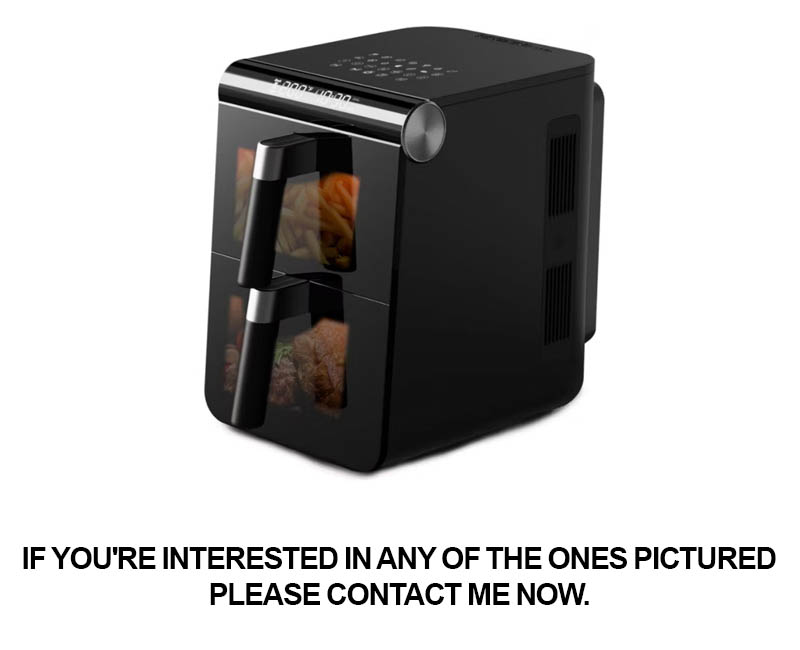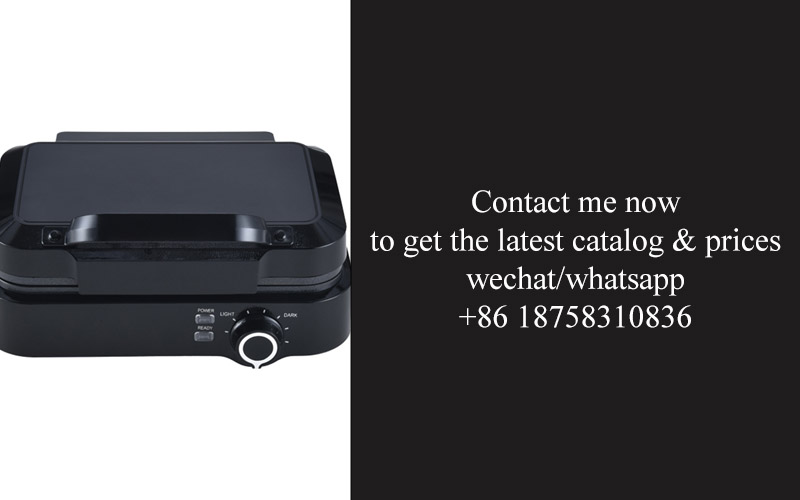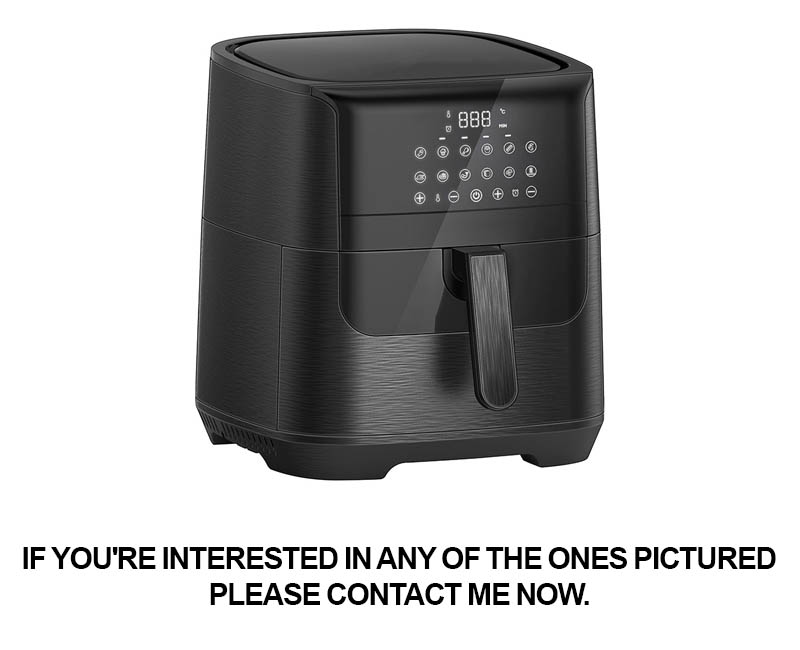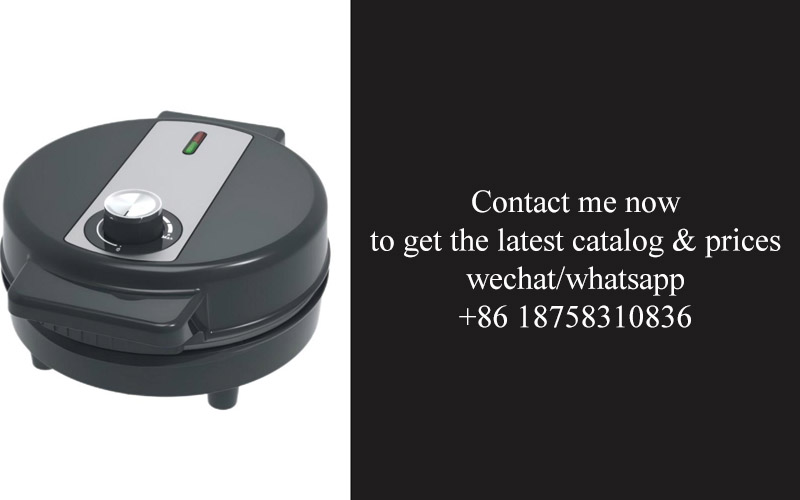Address
304 North Cardinal
St. Dorchester Center, MA 02124
Work Hours
Monday to Friday: 7AM - 7PM
Weekend: 10AM - 5PM
Address
304 North Cardinal
St. Dorchester Center, MA 02124
Work Hours
Monday to Friday: 7AM - 7PM
Weekend: 10AM - 5PM

In a world where culinary trends are ever-evolving, the kitchen appliance industry is constantly pushing boundaries. Among the latest innovations, restaurant-grade air fryers have emerged as a game-changer for home cooks, blending the convenience of fast food with the health benefits of home cooking. This article delves into the fascinating world of these advanced appliances, exploring their design, production, market trends, consumer benefits, and how they compare to traditional cooking methods. Join us as we uncover the eco-friendly aspects and the future of home cooking with restaurant-grade air fryers.
In recent years, the kitchen appliance industry has witnessed a remarkable transformation, with one standout innovation being the restaurant-grade air fryer. Once a staple in professional kitchens, these high-powered appliances are now making their way into the homes of culinary enthusiasts everywhere. This shift is not just a trend; it’s a game-changer that’s revolutionizing the way we cook.
These air fryers, designed to mimic the cooking capabilities of commercial kitchens, have garnered attention for their ability to produce restaurant-quality results without the need for excessive oil. The concept is simple yet revolutionary: hot air circulates around the food, creating a crispy outer layer while keeping the inside tender and juicy. This method not only cuts down on fat but also on cooking time, making it a favorite among health-conscious consumers.
The appeal of restaurant-grade air fryers is multifaceted. For starters, they offer a versatile cooking experience, capable of frying, roasting, baking, and even grilling. This versatility means that home cooks can enjoy a wide range of dishes, from crispy French fries to succulent chicken wings, all with minimal effort.
Moreover, the convenience factor cannot be overstated. These air fryers are compact yet powerful, making them perfect for small kitchens or those who prefer to cook in batches. Their ease of use is another selling point, with intuitive controls and digital displays that guide users through the cooking process.
The rise of restaurant-grade air fryers is also a testament to the evolving preferences of consumers. As people become more health-conscious, they are seeking out cooking methods that align with their dietary goals. The air fryer’s ability to provide a healthier alternative to deep-frying is a major draw, and it’s no surprise that this has propelled its popularity.
In the European and American markets, the demand for these air fryers has been particularly strong. European consumers, known for their appreciation of culinary excellence, have embraced the air fryer as a way to recreate their favorite restaurant dishes at home. Similarly, in the U.S., where convenience and health are top priorities, the air fryer has become a staple in many households.
The technology behind these air fryers is impressive. Advanced heating elements and a fan that circulates air at high speeds ensure that food is cooked evenly and quickly. Some models even come with features like temperature control and pre-programmed settings, making it easier than ever to achieve perfect results every time.
The production of restaurant-grade air fryers is a sophisticated process that involves precision engineering and quality control. Factories dedicated to these appliances are equipped with state-of-the-art technology to ensure that each unit meets the highest standards. From the materials used to the design of the fan and heating elements, every detail is carefully considered to deliver a product that can withstand the demands of both professional and home chefs.
Market trends indicate that the demand for restaurant-grade air fryers is only going to grow. As more people discover the benefits of these appliances, the competition among manufacturers is heating up. New features and innovations are constantly being introduced, such as non-stick coatings, removable baskets for easy cleaning, and even smart technology that allows users to control their air fryer remotely via their smartphones.
In conclusion, the rise of restaurant-grade air fryers is a clear sign of the changing landscape in kitchen appliances. It’s not just about cooking healthier, it’s about cooking better. These appliances are empowering home cooks to achieve professional-level results without the need for a commercial kitchen. As the technology continues to evolve and consumer awareness grows, it’s likely that restaurant-grade air fryers will become an indispensable part of the modern kitchen.

The European and American kitchen appliance industry has witnessed a remarkable transformation over the years, driven by evolving consumer preferences and technological advancements. This dynamic landscape offers valuable insights into the market trends and the factors that shape its growth.
In Europe, the market is characterized by a strong emphasis on sustainability and health-conscious living. Consumers are increasingly looking for appliances that not only enhance their cooking experience but also align with their eco-friendly lifestyles. Smart kitchen appliances, including air fryers, have gained popularity as they offer healthier alternatives to deep-frying while being energy-efficient.
The American market, on the other hand, is marked by a preference for convenience and innovation. American consumers are always on the lookout for the latest gadgets that can simplify their lives and offer new culinary possibilities. This has led to a surge in demand for high-tech kitchen appliances that combine performance with modern aesthetics.
One key trend in both regions is the integration of smart technology. Smart kitchen appliances, such as those with Wi-Fi connectivity, allow users to control their appliances remotely, track their usage, and even receive notifications for maintenance or updates. This level of connectivity is not only convenient but also contributes to a more sustainable approach to cooking, as users can optimize their energy consumption.
Another significant factor influencing the market is the rise of health and wellness. As people become more aware of the impact of diet on their overall well-being, they are seeking out appliances that can help them prepare nutritious meals without compromising on taste. Air fryers, in particular, have become a staple in many kitchens due to their ability to cook with minimal oil, making them a favorite among those looking to reduce their fat intake.
Brands in both Europe and America are responding to these demands by introducing a wide range of products that cater to different cooking styles and dietary needs. For instance, there are air fryers designed specifically for making crispy vegetables, others for baking desserts, and even some that can be used as a rice cooker or an oven.
In Europe, the market is also influenced by the diverse cultural backgrounds of its consumers. This diversity has led to the emergence of specialized appliances that cater to specific cuisines, such as Italian pasta makers or German sausages smokers. This niche approach highlights the industry’s ability to adapt and meet the unique preferences of different consumer groups.
On the regulatory front, both Europe and America have their own set of standards and certifications that manufacturers must adhere to. In Europe, for example, the CE marking is a symbol of compliance with the European Union’s health, safety, and environmental protection requirements. Similarly, in the United States, appliances must meet the strict guidelines set by the Underwriters Laboratories (UL) and the Consumer Product Safety Commission (CPSC).
The retail landscape in both regions is also a key driver of market trends. Online sales have seen significant growth, with more consumers turning to e-commerce platforms for convenience and the variety of options available. Brick-and-mortar stores, however, remain a vital part of the market, especially for high-end appliances where the in-store experience plays a crucial role in the purchasing decision.
Lastly, the kitchen appliance industry in both Europe and America is witnessing a shift towards sustainability and ethical manufacturing practices. Consumers are more informed and conscious of where and how their products are made, leading to an increased demand for appliances that are produced in an environmentally responsible manner.
In conclusion, the European and American kitchen appliance industry is a complex and ever-evolving market. It is shaped by a combination of technological advancements, consumer preferences, regulatory requirements, and retail dynamics. Understanding these factors is essential for manufacturers and retailers looking to navigate this dynamic landscape and meet the needs of today’s consumers.

In the ever-evolving landscape of kitchen appliances, air fryers have emerged as a staple for health-conscious and culinary enthusiasts alike. The latest iteration of these devices, however, goes beyond the basics, offering innovative designs that blend functionality with style. Here’s a closer look at the cutting-edge technology shaping the air fryer market.
The sleek and modern aesthetics of contemporary air fryers are a testament to the industry’s commitment to design. With a variety of finishes from brushed stainless steel to matte black, these appliances seamlessly integrate into any kitchen decor. The compact size and rounded edges make them not just a cooking tool but also a statement piece.
One of the standout features in the latest air fryer technology is the inclusion of smart capabilities. Many models now come with touchscreens that allow users to select pre-programmed settings for a range of foods, from crispy French fries to succulent chicken wings. These intuitive interfaces make cooking a breeze, even for those who are new to air frying.
The heat distribution has been significantly improved in the latest models. Advanced fans and heating elements ensure that the air circulates evenly, resulting in a more consistent and even cooking experience. This means that your food will be perfectly crispy on the outside while remaining juicy on the inside, just like it would be in a professional kitchen.
Safety has also been a focal point in the design of new air fryers. Features like automatic shut-off and cool-touch exteriors prevent accidents and make these appliances suitable for households with children. The inclusion of non-stick coatings that are PFOA-free also addresses health concerns, ensuring that no harmful chemicals leach into the food.
In terms of versatility, the latest air fryers are designed to do more than just fry. Many models now come with additional functions such as baking, roasting, and even dehydrating. This multipurpose functionality means that you can use a single appliance to prepare an entire meal, saving space and reducing the need for multiple kitchen gadgets.
The latest air fryers also boast a range of smart features that connect to your smartphone or tablet. Through dedicated apps, users can monitor cooking progress, receive notifications, and even control the appliance remotely. This connectivity not only adds convenience but also allows for the sharing of recipes and cooking tips with a community of fellow food lovers.
The design of the latest air fryers has also embraced sustainability. With energy-efficient heating elements and the ability to cook larger quantities of food at once, these appliances are designed to use less energy than traditional ovens. This not only reduces utility bills but also contributes to a smaller carbon footprint.
The latest air fryers are not just a cooking tool; they are a technological marvel. With their innovative designs, smart features, and commitment to safety and sustainability, these appliances are revolutionizing the way we cook at home. Whether you’re a seasoned chef or a novice cook, the latest in air fryer technology promises to enhance your culinary experience and make healthy, delicious meals a reality.

In the realm of kitchen appliances, the rise of restaurant-grade air fryers has been nothing short of revolutionary. These marvels of modern technology have not only transformed the culinary landscape but also highlighted the pivotal role that factory production plays in bringing these innovative products to life. Let’s take a behind-the-scenes look at how these high-performance air fryers are crafted with precision and care.
The journey begins with meticulous design, where engineers and designers collaborate to create air fryers that not only meet but exceed the demands of professional kitchens. Each component is carefully considered, from the durable outer shell to the intricate fan system that ensures even cooking. The manufacturing process is a blend of art and science, where every detail is crucial.
At the heart of restaurant-grade air fryers is the heat exchange technology. Factories invest in cutting-edge systems that allow for rapid and consistent heating, crucial for maintaining the integrity of the food. The fan is a marvel in itself, capable of generating a powerful, high-velocity airflow that circulates around the food, mimicking the frying process without the grease.
Quality control is paramount in the factory production of these air fryers. Every unit undergoes a rigorous testing phase to ensure it meets the stringent requirements of both durability and performance. Engineers monitor the temperature distribution, ensuring that the air fryer can handle a variety of cooking times and temperatures without overheating or burning the food.
The assembly line is a symphony of precision. Workers, often with years of experience, expertly fit the internal components into place, from the heating element to the cooling fan. The precision with which these parts are aligned is critical for the air fryer’s efficiency and longevity.
Once the mechanical aspects are complete, the aesthetics come into play. The outer shell is often made from high-quality stainless steel, not only for its resistance to corrosion but also for its sleek, commercial look. The design team works closely with the factory to ensure that each air fryer not only functions perfectly but also looks the part in a professional kitchen setting.
Innovation in factory production doesn’t stop at the design and assembly. Energy efficiency is a growing concern, and factories are continually seeking ways to reduce the environmental impact of their products. This includes the use of advanced insulation materials and energy-saving technologies that keep the air fryers running efficiently without wasting power.
Safety is another cornerstone of factory production. Air fryers are equipped with various safety features to prevent accidents, such as automatic shut-off functions that activate if the unit overheats or is left unattended. These features are thoroughly tested to ensure they activate precisely when needed, providing peace of mind to both the user and the manufacturer.
Customization is also a key aspect of factory production for restaurant-grade air fryers. Many kitchens have specific needs, whether it’s a particular size, capacity, or feature set. Factories often have the capability to modify the standard models to fit these unique requirements, showcasing their adaptability and commitment to customer satisfaction.
As the final touches are applied, the air fryers are readied for their final inspection. This involves a comprehensive check of all components, functionality, and safety features. Only once the product passes this meticulous review does it earn the label of quality assurance.
The factory production of restaurant-grade air fryers is a testament to human ingenuity and dedication. It’s a process that requires a deep understanding of both the culinary arts and the industrial world. From design to assembly, from quality control to safety features, every step is essential in creating a product that not only performs flawlessly but also stands as a beacon of innovation in the kitchen appliance industry.

In the ever-evolving world of kitchen appliances, staying ahead of the curve is crucial. Let’s delve into some of the latest market trends shaping the kitchen appliance sector, highlighting what’s currently hot.
Smart Integration is KingThe integration of smart technology into kitchen appliances has become a significant trend. From ovens that can be controlled via smartphone apps to refrigerators that can track your food inventory, smart integration is making appliances more user-friendly and efficient.
Energy Efficiency and SustainabilityWith environmental concerns on the rise, there’s a growing demand for energy-efficient appliances. Manufacturers are responding by producing appliances that consume less energy, which not only saves money but also helps reduce the carbon footprint. Sustainability is not just a buzzword but a core value driving innovation in the industry.
Minimalist and Aesthetic DesignsModern kitchens are increasingly looking for appliances that not only perform well but also complement the aesthetic of the space. Minimalist designs, with sleek lines and concealed controls, are becoming popular. Consumers are gravitating towards appliances that blend functionality with beauty.
Health and Wellness-Driven FeaturesHealth-conscious consumers are pushing the industry towards more wellness-focused features. Air fryers, for example, have seen a surge in popularity as they offer a healthier alternative to deep-frying. Similarly, steam ovens and multi-functional cookers are becoming more common, as they allow for healthier cooking methods without sacrificing convenience.
Customization and PersonalizationConsumers are no longer satisfied with one-size-fits-all appliances. There’s a trend towards customization, where appliances can be tailored to specific needs or preferences. This could range from adjustable settings on coffee machines to modular kitchen setups that can be adapted as lifestyles change.
Technology-Driven ConvenienceThe kitchen appliance industry is embracing technology to make cooking and cleaning easier. Smart refrigerators that can suggest recipes based on available ingredients, ovens that can preheat and cook to precise temperatures using Wi-Fi, and dishwashers that can be scheduled for off-peak hours are just a few examples of how tech is enhancing convenience.
Innovative MaterialsThe use of innovative materials in appliance construction is on the rise. Durable and easy-to-clean materials like stainless steel and ceramic are popular, but there’s also a growing interest in sustainable materials like bamboo and recycled plastics, which are not only eco-friendly but also add a unique aesthetic to appliances.
Interactive and Educational AppliancesAppliances that can educate and interact with users are becoming more prevalent. For instance, smart cooktops that can provide cooking tips and recipe ideas, or kitchen robots that can handle cooking tasks while teaching the user about different culinary techniques.
Smart Kitchen EcosystemsThe concept of a smart kitchen ecosystem is gaining traction. Appliances that can communicate and work together to create a seamless cooking experience are becoming more common. This trend is driven by the idea that a kitchen is not just a collection of tools but a cohesive system that enhances the overall cooking experience.
Market Trends in Emerging RegionsAs the world becomes more interconnected, the kitchen appliance market is expanding into emerging regions. There’s a growing demand for appliances that are both affordable and high-quality, as well as those that cater to specific cultural preferences and cooking styles.
The Rise of Subscription ModelsIn line with the broader subscription economy trend, some appliance manufacturers are exploring subscription models. Instead of purchasing appliances outright, consumers can subscribe to them and have them replaced or repaired as needed, providing a new level of flexibility and service.
In conclusion, the kitchen appliance sector is buzzing with innovation, driven by consumer demands for convenience, health, and sustainability. As these trends continue to evolve, it’s clear that the future of cooking is going to be more connected, efficient, and tailored to the individual.

In today’s rapidly evolving kitchen appliance sector, data-driven analysis plays a pivotal role in shaping future trends and consumer preferences. By examining key figures and making informed predictions, we can discern where the market is heading and how manufacturers should adapt. Here’s a glimpse into the data-driven insights that are shaping the future of the kitchen appliance industry.
The adoption of smart technology has been on the rise, and this trend is expected to continue. Smart appliances that can be controlled via mobile devices or integrated into home automation systems are becoming increasingly popular. Data shows that consumers are not only interested in convenience but also in the ability to monitor and manage their kitchen appliances remotely.
Energy efficiency is a significant driver in the kitchen appliance market. As consumers become more environmentally conscious, there is a growing demand for appliances that consume less energy. The latest data indicates that manufacturers are responding by producing appliances that not only save money on utility bills but also reduce the carbon footprint.
Health and wellness are at the forefront of consumer concerns, and this is reflected in the kitchen appliance sector. Air fryers, for instance, have seen a surge in popularity due to their ability to create crispy, fried foods with significantly less oil than traditional frying methods. Data analytics suggest that this interest in healthier cooking solutions will likely continue to drive innovation and market growth.
The rise of the “green kitchen” is another key trend. As consumers look to reduce waste and embrace sustainable living, appliances that are designed with recyclable materials or that promote food waste reduction are gaining traction. Data reveals that manufacturers are investing in research and development to create appliances that are not only eco-friendly but also cost-effective.
Smart kitchen systems that offer a seamless integration of various appliances are becoming more sophisticated. The data shows that these all-in-one systems are not just popular with tech-savvy consumers but also with those looking to streamline their cooking process. The future of kitchen appliances may involve appliances that not only work independently but also collaborate to optimize cooking times and energy use.
Consumer demographics are also influencing the kitchen appliance market. The aging population, for example, is driving the demand for appliances that are easy to use and require minimal maintenance. Data indicates that manufacturers are focusing on developing appliances with larger, clearer displays and simpler interfaces to cater to this demographic.
The integration of artificial intelligence (AI) into kitchen appliances is another area that is poised for significant growth. From voice-activated ovens to AI-driven refrigerators that can suggest recipes based on the contents of the fridge, the data suggests that AI will play a crucial role in personalizing the cooking experience.
Innovation in materials is also a key factor. The use of advanced materials such as ceramic-coated non-stick surfaces or high-quality stainless steel is becoming more common, offering better durability and performance. Data indicates that these materials not only enhance the longevity of appliances but also appeal to consumers who value high-quality products.
Predictions for the future of the kitchen appliance industry suggest that there will be a continued emphasis on sustainability, health, and smart technology. As consumers become more tech-savvy and environmentally conscious, the kitchen appliance sector is expected to see further integration of these values into the design and functionality of appliances.
Finally, the rise of e-commerce and the increased availability of kitchen appliances online have changed how consumers purchase and interact with these products. Data analytics are being used to understand consumer behavior and preferences, allowing manufacturers to tailor their marketing strategies and product offerings accordingly.
In conclusion, the kitchen appliance industry is a dynamic and ever-changing landscape, driven by a combination of consumer needs, technological advancements, and data-driven insights. By staying abreast of these key figures and predictions, manufacturers can stay ahead of the curve and continue to meet the evolving demands of their customers.

In today’s fast-paced world, the demand for convenience and high-quality cooking experiences has never been greater. Restaurant-grade air fryers have emerged as a game-changer, bridging the gap between professional-grade appliances and the home kitchen. Let’s delve into why these advanced devices have become a must-have for every home cook.
The precision and control offered by restaurant-grade air fryers are unparalleled. With their ability to mimic the deep-frying process without the oil, these appliances provide a healthier alternative to traditional frying methods. This is particularly appealing to health-conscious consumers who are looking to enjoy their favorite fried foods without the guilt.
Moreover, the technology behind these air fryers has evolved significantly, allowing for more efficient and even cooking. The innovative heat circulation system ensures that food is crispy on the outside and tender on the inside, replicating the texture of restaurant-quality fried dishes. This feature is not only a testament to the technological advancements in air fryer design but also a reason why they are a must-have for any aspiring chef at home.
The versatility of restaurant-grade air fryers is another reason why they have gained popularity. These appliances can cook a wide range of dishes, from crispy French fries to juicy chicken wings and even delicate vegetables. The ability to prepare so many different foods in one device makes meal prep quicker and more enjoyable. Whether you’re hosting a dinner party or just looking to spice up your weekday meals, a restaurant-grade air fryer can handle it all.
Safety features are also a significant factor that makes these air fryers a must-have. Many models come with automatic shut-off functions, overheat protection, and cool-touch exteriors, ensuring that you can cook with peace of mind. These features are particularly important for families with young children or individuals who may be prone to accidents in the kitchen.
In terms of energy efficiency, restaurant-grade air fryers are a winner. They use a fraction of the oil compared to traditional deep fryers, and their rapid air circulation cooks food at a lower temperature than conventional ovens. This not only saves on electricity bills but also reduces your carbon footprint. The eco-friendly aspect of these appliances is a compelling reason for many consumers to make the switch.
Another compelling reason to consider a restaurant-grade air fryer is the ease of use. These appliances are typically designed with user-friendly controls and intuitive interfaces. They come with digital displays that allow you to set the desired cooking temperature and time, ensuring consistent results every time. For those who are new to cooking or looking for a simpler way to prepare meals, this level of convenience is invaluable.
The social aspect of cooking cannot be overlooked. Restaurant-grade air fryers encourage family bonding and social interaction in the kitchen. They can be a fun way to involve children in meal preparation or to host a cooking competition with friends. The shared experience of cooking together can strengthen relationships and create lasting memories.
The quality of the ingredients used in cooking is crucial, and restaurant-grade air fryers do not compromise on this front. They are capable of delivering the same level of flavor as restaurant meals because they can reach high temperatures quickly, searing the outside of food to lock in the flavors. This is a significant benefit for those who love to cook but want to achieve professional results without professional equipment.
In conclusion, restaurant-grade air fryers are a must-have due to their health benefits, efficiency, versatility, safety, energy savings, ease of use, social value, and the ability to enhance the quality of ingredients. As kitchen appliances continue to evolve, these features make them a wise investment for anyone looking to elevate their home cooking experience.

In the realm of kitchen appliances, the emergence of restaurant-grade air fryers has sparked a revolution. These high-performance devices are not just kitchen gadgets; they are the epitome of innovation and efficiency. Let’s delve into how these advanced air fryers measure up against their traditional counterparts.
The first noticeable difference lies in the cooking capabilities. Restaurant-grade air fryers are designed to mimic the commercial-grade performance that professional chefs rely on. With their powerful heating elements and rapid air circulation, these fryers can achieve a crispy outer layer and a tender interior in a fraction of the time it takes a traditional deep fryer. This technology not only enhances the flavor of the food but also preserves nutrients better, making them a healthier option.
Traditional deep fryers, on the other hand, require submerging food in oil, which can lead to higher calorie content and potential health risks. The oil also needs to be monitored and frequently replaced, adding to the cost and effort of cooking. Restaurant-grade air fryers, however, use a minimal amount of oil, if any, and the air circulation ensures that the food is evenly coated, eliminating the need for constant oil management.
Ease of use is another area where restaurant-grade air fryers shine. These fryers often come with programmable settings and pre-programmed recipes, making it simple for anyone to achieve restaurant-quality results at home. The intuitive interfaces and user-friendly controls mean that even those who are not tech-savvy can enjoy the benefits of this modern appliance.
In contrast, traditional deep fryers require careful monitoring to prevent overheating and potential fires. They also demand a considerable amount of time to preheat and cool down, which can be a hassle for busy individuals or those short on time. The lack of advanced features in traditional fryers means that the cooking process is more labor-intensive and less predictable.
When it comes to cleaning, restaurant-grade air fryers have a significant advantage. The non-stick surfaces and the ability to cook a variety of foods at different temperatures make them much easier to clean. The air fryers’ design often includes features like dishwasher-safe parts, which further simplifies the cleanup process.
Traditional deep fryers, however, are notorious for being a pain to clean. The oil residue and food particles can be difficult to remove, and the risk of cross-contamination is higher due to the shared cooking environment. The need for frequent oil changes and the potential for oil to become rancid also contribute to the cleaning challenges.
Energy efficiency is a crucial factor that sets restaurant-grade air fryers apart. These fryers use less energy than traditional deep fryers, which not only reduces utility bills but also contributes to a greener footprint. The rapid cooking process and the absence of large volumes of hot oil also minimize the risk of accidents and fire hazards.
Traditional deep fryers, while they have their place in certain cooking techniques, are less energy-efficient and can be more dangerous to use. The high temperatures and large quantities of oil can lead to overheating and the release of harmful fumes, which is a concern for both health and the environment.
The versatility of restaurant-grade air fryers is another standout feature. They can be used to prepare a wide array of dishes, from crispy fried chicken to roasted vegetables and even desserts. The ability to cook with minimal oil makes them suitable for health-conscious consumers who still want to enjoy their favorite fried foods.
In contrast, traditional deep fryers are limited to fried foods and often require a separate oven or stove for other cooking methods. This lack of versatility can be a drawback for those who enjoy a diverse range of culinary experiences.
Lastly, the cost factor is worth considering. While restaurant-grade air fryers may have a higher upfront cost than traditional models, they can offer significant long-term savings. The reduction in oil usage, the elimination of the need for frequent oil changes, and the energy efficiency all contribute to a more cost-effective cooking experience.
In summary, restaurant-grade air fryers are a leap forward in kitchen technology. They offer superior cooking performance, ease of use, and health benefits over traditional deep fryers. The investment in a high-quality restaurant-grade air fryer can pay off in the form of delicious, nutritious meals, a safer kitchen environment, and a more sustainable approach to cooking.

Modern air fryers, particularly those designed with restaurant-grade quality, are not just cooking devices; they are eco-friendly champions in the kitchen. Here’s a deep dive into the sustainability and energy efficiency aspects that make these appliances a greener choice for homeowners and businesses alike.
In the heart of every restaurant-grade air fryer lies an advanced heating element, typically a halogen lamp, which provides a focused heat source that is far more efficient than traditional frying methods. This targeted heating reduces the overall energy consumption, making it an eco-friendly choice that minimizes carbon footprints.
One of the most significant benefits of modern air fryers, especially restaurant-grade models, is their ability to use less oil compared to deep frying. This not only makes for healthier cooking but also reduces the amount of oil that would otherwise end up in landfills. With oil consumption cut by as much as 80%, these fryers contribute less to waste and the pollution associated with oil disposal.
The materials used in the construction of these fryers are also a testament to their commitment to sustainability. Many are made with recycled steel and aluminum, which are both recyclable and have a lower environmental impact when compared to other metals. The non-stick surfaces are also designed to last, reducing the need for frequent replacements and the resultant waste.
Energy efficiency is a cornerstone of modern air fryer technology. These appliances are designed to maintain optimal cooking temperatures with precision, ensuring that heat is used efficiently. The smart thermostats inside these fryers automatically adjust the temperature, preventing unnecessary energy usage and heat loss that occurs in traditional ovens.
Another interesting aspect of restaurant-grade air fryers is their modular design, which allows for easier cleaning and maintenance. Regular maintenance is crucial for sustainability, as it prevents the buildup of grease and grime that can lead to inefficiencies and higher energy consumption. The ease of disassembly and cleaning ensures that these fryers remain in top working condition for longer, extending their lifespan and reducing the frequency of disposal.
In terms of operational costs, restaurant-grade air fryers have a clear advantage over traditional cooking methods. Not only do they use less oil and energy, but they also heat up faster, allowing for quicker cooking times. This means less waiting time and, consequently, lower energy usage during idle periods.
The compact and space-saving design of these fryers also plays a role in sustainability. By occupying less space on the countertop, they free up area for other appliances that may consume more energy when left idle. The ability to stack or mount these fryers vertically in commercial kitchens further optimizes space usage and reduces the overall energy footprint.
For businesses, the cost savings associated with restaurant-grade air fryers can be substantial. By reducing energy consumption and extending the life of the fryers through regular maintenance, companies can cut down on operational expenses. This is especially beneficial in fast-food restaurants and cafes where high energy costs are a common concern.
On a consumer level, the eco-friendly aspects of air fryers are equally appealing. Home cooks are increasingly aware of the environmental impact of their food choices and cooking methods. A restaurant-grade air fryer allows them to enjoy the crispy texture of fried foods without the guilt, making it a popular choice among health-conscious individuals.
The technology behind these fryers is also constantly evolving. Innovations like smart technology integration are making air fryers even more sustainable. With features that optimize cooking times and temperatures, these fryers not only save energy but also reduce food waste by ensuring that food is cooked perfectly every time.
Moreover, the longevity of restaurant-grade air fryers is a factor that supports sustainability. Unlike some other kitchen appliances that may need frequent replacing due to breakdowns or inefficiencies, these fryers are built to last. This means less waste and a reduced need for raw materials to produce new appliances.
In conclusion, the eco-friendly nature of modern restaurant-grade air fryers is a result of several factors, from efficient heating elements and smart technology to sustainable materials and design. As awareness of environmental issues grows, these appliances offer a compelling alternative that aligns with a greener lifestyle and provides tangible benefits for both consumers and businesses.

In today’s fast-paced world, the convenience and quality of home cooking have become a top priority for many. The advent of restaurant-grade air fryers has revolutionized the way we approach meal preparation at home, offering a fusion of professional-grade capabilities with user-friendly designs. Here are some final thoughts on why these advanced appliances are becoming an indispensable part of modern kitchens.
As we delve into the world of restaurant-grade air fryers, we find that they often come equipped with advanced features that elevate them beyond the typical consumer models. From adjustable temperature controls to digital timers and smart connectivity, these devices are designed to provide a more personalized and precise cooking experience. This level of control allows for the perfect texture and taste, whether you’re preparing crispy French fries or succulent fried chicken.
Moreover, the health benefits of these air fryers cannot be overstated. By using a fraction of the oil compared to traditional deep fryers, restaurant-grade air fryers offer a guilt-free alternative that is lower in calories and fats. This shift towards healthier cooking methods is a significant trend in the kitchen appliance sector, as consumers increasingly prioritize their health and well-being.
The design of these air fryers also reflects a move towards functionality and aesthetic appeal. Many models feature sleek, modern aesthetics that complement a variety of kitchen decors. Additionally, the compact and space-saving designs make them perfect for urban kitchens or those with limited counter space. This blend of form and function addresses the needs of consumers who value both the appearance of their appliances and their efficiency.
The sustainability aspect of these air fryers is yet another reason for their growing popularity. As environmental concerns rise, consumers are seeking appliances that are energy-efficient and eco-friendly. Restaurant-grade air fryers, with their reduced oil usage and energy consumption, contribute to a greener kitchen. This aligns with the broader trend of sustainability in the kitchen appliance industry, where manufacturers are under increasing pressure to create products that are environmentally responsible.
In the realm of innovation, the integration of smart technology in restaurant-grade air fryers is a game-changer. Many models now offer remote control and monitoring through smartphones or tablets, allowing users to prepare meals from anywhere in the home. This feature is particularly useful for busy professionals or those who prefer to multitask. The ability to program cooking times and temperatures also ensures that food is ready precisely when you need it, without the need for constant supervision.
While restaurant-grade air fryers offer numerous advantages, it’s important to consider their cost. These high-end appliances are generally more expensive than traditional air fryers and some basic cooktop models. However, their durability and longevity can offset the initial investment. Moreover, the potential health and time savings over the long term make them a worthwhile investment for many families and individuals.
The consumer benefits of restaurant-grade air fryers extend beyond health and convenience. They also provide a sense of culinary adventure. With the ability to replicate restaurant-quality dishes at home, users can explore new flavors and techniques without the price tag or wait time associated with dining out. This empowers home cooks to experiment and enhance their culinary skills, turning their kitchen into a personal gourmet paradise.
As we look to the future, the trajectory of the air fryer market is clear. Innovations in technology and design will continue to push the boundaries of what’s possible in the kitchen. We can expect to see further integration of smart features, more energy-efficient models, and perhaps even air fryers that can be tailored to individual dietary needs. The possibilities are vast, and the kitchen is set to become a more dynamic and interactive space.
In conclusion, restaurant-grade air fryers are more than just kitchen gadgets; they represent a leap forward in how we approach meal preparation. Their combination of health benefits, convenience, and innovative technology makes them a must-have for anyone looking to elevate their home cooking experience. As we continue to embrace the future of cooking, these appliances are poised to become an integral part of modern kitchen landscapes.